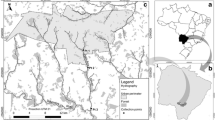Abstract
This study was primarily aimed at investigating the physicochemical and microbial quality of water in 14 such dugouts from five districts in the northern region of Ghana. Results obtained suggest that except for colour, turbidity, total iron and manganese, many physicochemical parameters were either within or close to the World Health Organisation’s acceptable limits for drinking water. Generally, colour ranged from 5 to 750 Hz (mean 175 Hz), turbidity from 0.65 to 568 nephelometric turbidity units (NTU; mean 87.9 NTU), total iron from 0.07 to 7.85 mg/L (mean 1.0 mg/L) and manganese from 0.03 to 1.59 mg/L (mean 0.50 mg/L). Coliform counts in water from all the dugouts in both wet and dry seasons were, however, above the recommended limits for drinking water. Total and faecal coliforms ranged from 125 to 68,000 colony forming units (cfu)/100 mL (mean 10,623 cfu/100 mL) and < 1 to 19,000 cfu/100 mL (mean 1,310 cfu /100 mL), respectively. The poor microbial quality, as indicated by the analytically significant presence of coliform bacteria in all samples of dugout water, strongly suggests susceptibility and exposure to waterborne diseases of, and consequent health implications on, the many people who continuously patronise these vital water resources throughout the year. In particular, more proactive sustainable water management options, such as introduction to communities of simple but cost-effective purification techniques for water drawn from dugouts for drinking purposes, education and information dissemination to the water users to ensure environmentally hygienic practices around dugouts, may be needed.
Similar content being viewed by others
References
APHA (1998). Standard methods for the examination of water and wastewater, 20th ed. Washington, DC: APHA.
Baird, C (1999). Environmental chemistry (2nd ed., p. 419). New York: Freeman.
Chapman, D. (1992). Water quality assessment: A guide to the use of biota, sediments and water in environmental monitoring (585 pp.). Cambridge: Cambridge University Press.
Ghana Statistical Service (2002). 2000 Population & Housing Census: Special Report on 20 Final Results, G.S.S. (62 pp.).
Grabow, W. O. K. (1996). Waterborne diseases: Update on water quality assessment and control. Water S.A., 22, 193–202.
Karikari, A. Y., Bernasko, J. K., & Bosque-Hamilton, E. K. A. (2007). An assessment of water quality of Angaw River in southeastern coastal plains of Ghana. West Africa Journal Applied Ecology, 11, 77–87.
Kesse, G. O. (1985). The mineral and rock resources of Ghana (610 pp.). Rotterdam: Balkema.
Kranjac-Berisavljevic, G., Bayorbor, T. B., Abdulai, A. S., Blench, R. M., Turton, C. N., & Boyd, C. (1999). Rethinking natural resource degradation in semi-arid sub-Saharan Africa: The case of semi-arid Ghana. London, UK: Faculty of Agriculture, University for Development Studies, Tamale, Ghana, in collaboration with Overseas Development Institute (ODI).
Kwei, C. A. (1997). Evaluation of groundwater potential in the Northern Region of Ghana. A report submitted to Canadian International Development Agency.
Obiri, S. (2007). Determination of heavy metals in water from boreholes in Dumasi in the WassaWest district of western region of Republic of Ghana. Environmental Monitoring and Assessment, 130, 455–463. doi:10.1007/s10661-006-9435-y.
Rast, W., & Thornton, J. A. (1996). Trends in eutrophication research and control. Hydrological Processes, 10, 295. doi:10.1002/(SICI)1099-1085(199602)10:2<295::AID-HYP360>3.0.CO;2-F.
Sawyer, C. N., McCarty, P. L., & Parkin, G. F. (1994). Chemistry for environmental engineering (4th ed., pp. 485–601). Singapore: McGraw-Hill.
WHO. (2003). Nitrate and nitrite in drinking-water. Background document for preparation of WHO Guidelines for drinking-water quality. Geneva, World Health Organization (WHO/SDE/WSH/03.04/56).
WHO. (2006). Guidelines for drinking water quality, vol. 1, Recommendation. Geneva: World Health Organisation.
Author information
Authors and Affiliations
Corresponding author
Rights and permissions
About this article
Cite this article
Cobbina, S.J., Anyidoho, L.Y., Nyame, F. et al. Water quality status of dugouts from five districts in Northern Ghana: implications for sustainable water resources management in a water stressed tropical savannah environment. Environ Monit Assess 167, 405–416 (2010). https://doi.org/10.1007/s10661-009-1059-6
Received:
Accepted:
Published:
Issue Date:
DOI: https://doi.org/10.1007/s10661-009-1059-6




